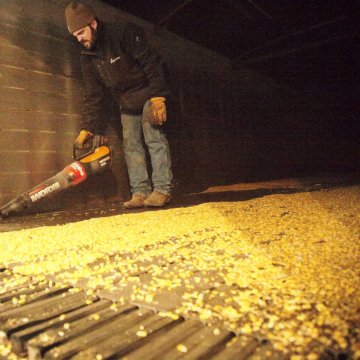
The look on Cory Hall’s face said it all when I handed him the tool I had asked the Winterset, Iowa, farmer to evaluate. “I’ll admit, I was disappointed,” Hall recalls. “What in the heck was I supposed to do with a leaf blower around here?”
Due to advances in battery capacity and brushless motors, leaf blowers have graduated to high-volume blowers, offering farmers the ultimate portable clean-up tool for their operations.
“My dad and I soon discovered it could be used to clean out our trailers,” says Bryson Hall (pictured above blowing out a trailer with a live floor). “That thing will blow a foot of corn out of a trailer in no time.”
The Halls also found myriad chores for their Worx Turbine WG591 to tackle – from cleaning out grain bins (“They cut cleaning time in half,” Cory observes) to blowing out a combine (“Without having to get air hoses and a compressor out. We can use it in the field at the end of the day,” Bryson adds).
Agriculture.com reader Buckfarmer uses his blower to “supercharge a burning brush pile or stump. A pile that may take a day can be burned in just a few hours with the help of lots of air,” he explains.
OFFERING CAPACITIES NEARLY AS GOOD AS GAS
Certainly gas-power blowers are available that turn out more air (some models turn out up to 700 cfm) than the battery-power units compared in this Product Test Team report (see page 38). But the advantage to battery blowers is their convenience. They don’t need fuel (and you avoid the mess of mixing gas and oil required for two-cycle engines), engine oil, or related maintenance items such as filters.
In addition, battery-power blowers generate less noise and heat, and they are lighter and smaller than gas-power models. As long as you keep the batteries charged (recharge times vary from 30 to 90 minutes), battery blowers offer instant on-the-spot starting.
SIZING UP CAPACITY
Unlike other cordless tools that often reveal their work capacity by the tool’s voltage, higher voltage doesn’t always equate to greater work power with cordless blowers. Instead, the first-cut gate to employ when sizing up a tool is how many miles per hour (mph) and cubic feet per minute (cfm) the blower generates.
A mph rating is self-explanatory but can be deceiving when this measure of performance is used alone. Often, manufacturers will only list mph rating. A blower that turns out 160 mph appears impressive. But if the volume of air that blower generates at that speed is low, the tool will have a lower capacity to move objects.
As such, you will want to first focus on a blower’s cfm capacity. This rating measures the volume of air moving through the blower in one minute.
A simplistic example of mph vs. cfm can be made by comparing a house broom to a shop broom. A house broom, measuring 12 to 15 inches wide, can be swung back and forth faster creating (in this simplistic comparison) a higher mph rating. But a 24- to 36-inch-wide shop broom moves more dirt with one motion, creating more work volume, or cfm.
But cfm is meaningless if it is not moving fast enough, which is why mph is also important. Ideally, you want the best of both worlds: a blower that turns out a high volume of air at a high speed.
The other figure worth considering when buying a blower is a tool’s watt hours. Unfortunately, this figure is rarely displayed on the tool. Instead, manufacturers prefer to list a tool’s output voltage, which is a general indicator of power.
Another rating often listed by manufacturers is battery amp hours. In simplistic terms, “amp hours describe the size of the battery’s fuel tank,” explains Bob Hunter, tool evaluator for Wood magazine, Successful Farming magazine’s sister publication. “The higher the amp-hour rating, the longer a cordless tool will run.”
There is an interrelationship between battery voltage and amp hours. This explains why the Milwaukee 2728-21HD, which has the lowest voltage of the tools listed below, can still turn out a high volume of air. The Milwaukee tool feeds from a 9-amp-hour battery.
To level the field when comparing battery blowers, calculate a tool’s watt hours by multiplying its voltage by amp hours. In the case of the Milwaukee blower, that would be 162 watt hours. Team the Milwaukee blower up with that company’s newly introduced 12-amp-hour battery, and you have a tool that turns out 216 watt hours of work, which makes it competitive with blowers with higher voltage.
OTHER FEATURES
There are a number of feature differences that exist among cordless blowers that are worth considering when buying these tools.
- Brushless motor. This state-of-the-art advance in cordless tools eliminates brushes and a physical commutator, greatly boosting motor life and efficiency.
- Inline fan design. All the models listed below (except for the DeWalt unit) use axial fans to propel air in one direction through the blower, which can boost tool efficiency compared with centrifugal fan blowers. All the inline fan models listed draw air in from the rear of the blower and away from clothing, which can restrict airflow.
- Variable speed. Being able to slow a blower down comes in handy when finishing out a grain bin or a shop floor; it raises less dust.
- Cruise control. Some form of a trigger locking mechanism is available on all the blowers listed except the Stihl unit. The advantage of a lock is that it saves stress on the trigger finger.
- Battery gauge. A gauge that indicates battery level may not seem like a big thing, but this feature proves its worth on blowers since they are energy hogs compared with other cordless tools.
